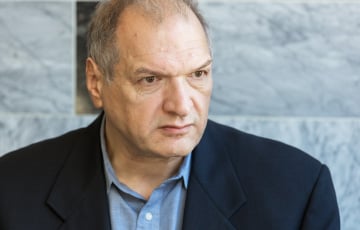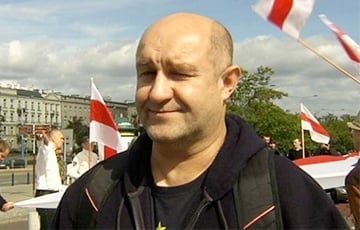Belarus in NATO Is The Key To Security Of Europe
8- Yuri Felshtinsky
- 18.06.2024, 20:02
- 10,800

PHOTO: CHARTER97.ORG
A single bloc of allied states should appear along the borders of Russia.
Charter97.org presents articles from the book by the European Belarus Foundation. The famous American historian and writer Yuri Felshtinsky wrote this article.
The Eastern European state of Belarus, bordering Russia, Poland, Ukraine, Lithuania, and Latvia, and being a kind of buffer between Russia and Europe and having no ports of its own in the modern world is intended to be a convenient transit zone connecting East and West, Russia and Europe. This has been the case since late 1991 when Belarus gained its independence. By 2022, this transit zone became a springboard for Russia's planned invasion of Ukraine and the invasion of Russian troops in Eastern Europe after the seizure of Ukraine.
The transformation of Belarus from an independent democratic country to a Russian protectorate led by a Kremlin-controlled dictator took 25 years. Aliaksandr Lukashenka, elected president in 1994, believed neither in democracy nor in the independence of his country.
His election was the result of the Belarusian people's fatigue from the severe economic turmoil of the early 1990s caused by the collapse of the USSR and the disappearance of the planned state economy (familiar to Soviet citizens), which had not yet been replaced by the market economy. It came into operation a little later. These economic shocks were easily played on by the cunning Lukashenka, who promised his voters stability and prosperity. The price of this stability was not yet clear in 1994.
On December 8, 1999, shortly before his resignation from the presidency, the decrepit Boris Yeltsin (who on December 31 would place Russia under the control of state security – namely Putin) signed a decree “On the creation of the Union State of Russia and Belarus.” By then Lukashenka was already an authoritarian dictator. Putin was only starting this path. Both of them refused to release their power. Both remain in charge of their countries for life.
More and more, Belarus was drawn into the orbit of the Russian Federation, gradually becoming a springboard for the Russian aggression against its neighbors. First of all, Ukraine, Poland, and Lithuania were in the risk zone. The Russian air bases in Belarus, constant joint exercises, and Russia's formal commitment to protect the external border of Belarus became real indications that in the upcoming military conflict, Belarus would be on Russia's side and would provide its territory for the attack.
Russia's first military campaign against Ukraine, launched in March 2014, was only partially successful. Russia seized Crimea and launched Operation Novorossiya to seize eastern and southern Ukrainian territories and break through to Moldova's Transnistrian region, where Russian troops, numbering 3,500 at the time, had been concentrated since 1995. However, the Novorossiya Operation failed. Russian troops were unable to make their way to Transnistria. Apart from Crimea, Russia's only success in the 2014 campaign could be considered the unleashed war in Donbas and the formal formation of the unrecognized "Donetsk" and "Luhansk" People's Republics.
Belarus avoided direct participation in that armed conflict on the side of Russia, but in the political and diplomatic sphere, it openly supported Russian aggression. It is not by chance that the bondage terms of the "peace agreements" imposed on Ukraine were formalized in Minsk and were called “Minsk agreements.”
The situation in Belarus changed dramatically after Lukashenka lost the 2020 presidential election. Lukashenka refused to admit defeat and leave office. The protest movement was brutally suppressed, including with the help of Russian troops who were secretly transferred from Russia and dressed in Belarusian uniforms. Lukashenka managed to stay in power, now as a dictator. But he lost any autonomy in his relations with Russia and Putin.
Belarus was gradually being flooded by the Russian army. The year 2022 was approaching, and Russia was scheduled to invade Ukraine. Belarus was to play a vital role in this military campaign: the target of the main strike of the Russian army this time was Kyiv, and they would attack from Belarus. Starting the 2022 campaign with strikes from the South and East, as was done in 2014, would mean turning the war into trench warfare from the first weeks of advance. The offensive from the North against Kyiv was supposed to provide Russia with a victorious blitzkrieg, comparable to the Crimean operation of March 2014.
Lukashenka provided the territory of Belarus to concentrate Russian troops and attack Kyiv. Shortly after the war began, at Putin's direction, he called Ukrainian President Vladimir Zelensky on Putin's behalf and offered for Ukraine to capitulate. Zelensky refused.
The war has been going on for a year and a half and has claimed the lives of hundreds of thousands of people. It can end under three conditions: if Ukraine's Western allies decide to provide Ukraine with the necessary number of offensive weapons, including long-range missiles; if they allow Ukraine to use these weapons to strike the territory of the enemy - the Russian Federation, including Moscow; and if they, together with Ukraine, eliminate the threat to Ukraine, Poland, Lithuania, and Latvia coming from Belarus, because today, after a year and a half, Belarus continues to be the most important geopolitical springboard for Russian aggression in Europe. This is indicated by numerous aggressive statements of the Belarusian dictator Lukashenka and his propagandists, the withdrawal of Belarus from the status of a nuclear-weapon-free state at the end of February 2022, and, finally, the beginning of transfers to Belarus of Russian tactical nuclear weapons and military formations of the Wagner Group threatening to invade Ukraine, Poland, and Lithuania from the Belarusian territory.
One can consider many theoretically possible scenarios for the end of the Russian-Ukrainian war. But none of these scenarios will guarantee peace for Ukraine and Eastern Europe unless it provides for the simultaneous liberation of Belarus from Russian occupation, the fall of the Lukashenka regime, and the restoration of democracy in Belarus. In fact, without the liberation of Belarus, it is impossible to end the Russian-Ukrainian war.
At the same time, Russia's loss of control over Belarus would make it impossible for Russia to conduct military operations against Ukraine from the north, condemning it to trench warfare against the Ukrainian army in the south and east, the two directions, that from the military and strategic points of view are absolutely hopeless. ussia can neither win the war against Ukraine nor make any significant progress in this war deep into Ukraine from the East and South if it loses Belarus, while Eastern Europe, with the liberation of Belarus, would acquire the most important security buffer separating Eastern Europe and Russia.
Belarus has all the necessary conditions to restore its independence. The population of this country already demonstrated its commitment to democracy in 2020, when it tried to force Lukashenka to resign through a peaceful protest movement. Hundreds of opposition politicians ended up behind bars. A number of opposition leaders have been forced to leave the country. They are abroad and are ready to return to their homeland to continue their activities as soon as circumstances allow.
Tens of thousands of Belarusians left the state, where it was now impossible to live and work freely. But they will return to Belarus with the return of democracy. The spine of the armed forces of free Belarus today already fight together with the Ukrainian army against Russian aggression in Ukraine. These people are ready to initiate and lead the national liberation movement of Belarus, for its liberation from Lukashenka's regime and Russian occupation. The natural allies of Belarus in this struggle will be Ukraine and NATO countries, interested in eliminating the threat to Europe from the Lukashenka regime controlled by Putin.
At the legislative level, a democratic Belarus will have to revise and disavow all of the agreements that were reached by the old government to the detriment of the country's interests and independence. Belarus must regain its nuclear-free status, renounce the deployment of Russian nuclear weapons on its territory, withdraw from numerous political agreements with Russia, including the Union Treaty of December 8, 1999, and various military agreements, and refuse to cooperate with Russia through the CIS, CSTO, and EAEU. Withdrawal from these interstate structures is a prerequisite for Belarus' independence.
To ensure the military-political and economic security of its country in the future, the new government of Belarus will have to consider joining NATO, on the one hand, and the European Union, on the other. Bringing Belarus as well as Ukraine into NATO and the EU will finally allow Europe to create a single bloc of allied states along Russia's borders, capable of countering any potential military threat coming from Russia, guaranteeing the European continent the peace that Russia has broken in this century at least four times: in August 2008 (in Georgia), in March 2014 (in Ukraine), in January 2022 (in Belarus), and in February 2022 (again in Ukraine).
Belarus will not be able to preserve its independence if it remains outside NATO and the EU and instead declares neutrality or joins some regional associations like the Baltic-Black Sea Union.
The question of another Russian attempt to seize it will only be a matter of time. Just as it was a matter of time for Ukraine in 2014-2022.
Reference
Yuri Felshtinsky is a Russian-American historian.
He is the author of “Blowing Up Ukraine: The Return of Russian Terror and the Threat of World War III” and “From Red Terror to Terrorist State: Russia’s Intelligent Services and Their Fight for World Domination”.










